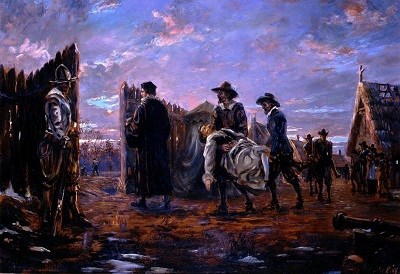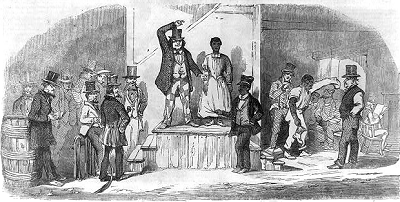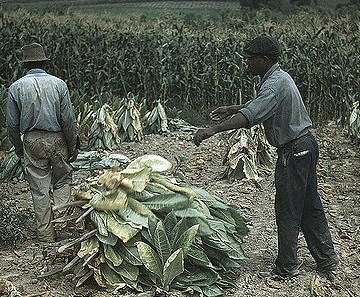Last updated: September 16, 2022
Article
2. Rise of the Colonial Plantation System

Sidney King, artist
Hundreds
In 1606, King James I created the Virginia Company of London. Its goal was to establish colonies in the New World. As a joint stock company, it sold shares to raise money. Jamestown was the first successful colony. Surviving in a new environment was hard. Severe drought had stressed food supplies for everyone. The winter of 1609-1610 is known as the "Starving Time." Food shortages, weak leadership, and attacks by the Powhatan killed two out of every three colonists. Those that survived struggled with diseases like dysentery and typhoid. It became hard to recruit settlers to go to the Virginia colony. Instead of offering shares, the Virginia Company of London offered land. Any adult male who could pay their own way to Virginia was promised 50 acres of land. They also encouraged new investors to assemble a group of settlers and start a "plantation" away from Jamestown. These settlements, called hundreds, were allowed more self-government. They were controlled by the Virginia Company's chief manager in Jamestown. They were meant to support one hundred heads of household. For example, Berkeley Plantation was established in 1619 as Berkeley Hundred when Captain John Woodlief arrived with 38 colonists.
Establishing a colony was not the only goal of the Virginia Company of London. It also wanted to make money. There were no flowing rivers of gold and jewels like the colonists believed. Instead, glass making, pitch and tar production, and beer and wine making allowed them to use natural resources. But this was not enough. John Rolfe, Pocahontas' husband, had introduced tobacco from the Caribbean in 1610. After Pocahontas died in England in 1617, he returned to Virginia and became a member of the council. He also sat as a member of the House of Burgesses, the first legislative assembly of elected representatives. By 1617, tobacco exports to England totaled 20,000 pounds. In 1619, the General Assembly began requiring tobacco inspections and mandating the creation of port towns and warehouses. These requirements helped major settlements like Norfolk, Alexandria, and Richmond to develop by the end of the century. By 1620 exports had risen to 50,000 pounds. In 1624, the Virginia Company of London declared bankruptcy and royal control was established. A governor and assembly appointed by the King would rule the colony until 1776.

Courtesy of Library of Congress
Human Labor
Life in the New World was hard for the immigrants. Colonists realized that they needed cheap labor to help work the land. Indentured servants solved that problem. The Virginia Company of London started this system where poor, white workers could gain free passage to the New World in exchange for working. Their contracts lasted four to seven years and were harsh and restrictive. Contracts could be extended if they tried to run away or if a woman became pregnant. Once their contract expired they were given a freedom package. This package could include 25 acres of land, clothes, and a year’s worth of supplies. Very few indentured servants became elite members of colonial society.
The first Africans arrived in Virginia in 1619. They were known as the “20 and odd”. They were brought to Jamestown onboard the English warship, White Lion. The 20 Africans were captives that were removed from a Portuguese slave ship, the San Juan Bautista. The Portuguese ship was on its way to deliver the Africans to Mexico. At that time in Jamestown there were no slave laws, and African captives were treated like indentured servants and given the same opportunities for freedom as white. By the mid1600s, the tobacco economy had grown tremendously. As demand grew, so did the cost of indentured servants. Slavery quickly replaced indentured servitude as the preferred source of human labor. Landowners were threatened by the prospect of newly freed servants demanding land. Enslaved Africans were viewed as a more profitable and renewable source of labor. In 1661, Virginia formally recognized slavery. By law, white indentured servants were forbidden from running away with a black servant. In 1662, Virginia passed a law that stated children would be free or bonded based on the status of the mother. This meant that a child born to an enslaved woman would also be enslaved, making slavery hereditary. By 1705, the Virginia General Assembly declared that all those not born into Christianity in their native land, would be enslaved for life.
Treatment of enslaved Africans varied by time and place. In most cases it was brutal, and abuse was common. Enslaved Africans were not allowed to learn how to read and write. At any moment mothers, fathers, brothers, and sisters could be sold. They were considered to be property, to be bought, sold, and bred like cattle. Working conditions were harsh. Many enslaved Africans worked from sun up to sun down. Access to adequate food, clothing, and medical attention was limited. However, not all Africans/ African Americans were born into slavery or stayed slaves their entire lives. Lott Cary was a former slave who became a Baptist minister and lay physician. He purchased his freedom and the freedom of his children when he was 33. Other slaves with lenient masters had the opportunity to earn money and purchase their freedom too. By the Civil War there were over 58,000 free blacks in Virginia and almost 500,000 slaves. Many free blacks lived in cities like Petersburg and Richmond. The Pocahontas Island Historic District had 310 free African Americans living in a community by 1800.

Courtesy of Library of Congress
Plantation and Cash Crops
Tobacco was Virginia's first cash crop. A cash crop is any crop for raised for its profits rather than its use. It was a labor intensive crop, requiring cheap labor and cheap land. Start-up costs were expensive.
Early settlers used the Native American method to clear the land. They girded trees, burned the underbrush, and then planted their crops. From start to finish, producing tobacco took a full year to grow and harvest. Planters could only grow tobacco in particular fields for three years. After that the fields had to lie dormant to allow the nutrients to return to the soil. This required more and more land. Thus after time, a plantation came to describe large areas of land that were devoted to agriculture, rather than a new settlement or colony.
By the end of the 1600s, the Virginia tobacco economy was thriving. Tobacco profits helped to buy indentured servants and slaves. They also were used to pay local taxes and buy manufactured goods from England. With relatively cheap labor, increasing demand and a system of regulation the colonial plantation system was born. Shirley Plantation is a premier example of a Virginia tobacco plantation.
Once tobacco became popular and profitable, everyone wanted to plant it. Colonial authorities had to require farmers to grow food crops, particularly corn. Farmers also grew peas, barley, turnips, cabbage, pumpkins, carrots, and herbs. This did not stop the overproduction of tobacco. Overproduction caused tobacco prices to drop. To stabilize prices, colonial authorities restricted the number of plants farmers could grow. Farmers were only allowed to plant 1,500 tobacco crops. Low tobacco prices caused a group of farmers to cut down tobacco seedlings in 1682. This caused a temporary demand for tobacco and prices began to rise again.
Overproduction caused tobacco prices to drop again to a penny per pound. By 1709, the Virginia colony was producing 29 million pounds of tobacco per year. Tobacco prices remained low until the 1730s, and stable through the 1740s and 1750s. By the start of the American Revolution in 1775, the Virginia General Assembly voted to stop tobacco export to Europe. Farmers switched to wheat production to help the troops. Historians estimate that the total tobacco production between 1776 and 1782 equaled one year’s output before the war began.
